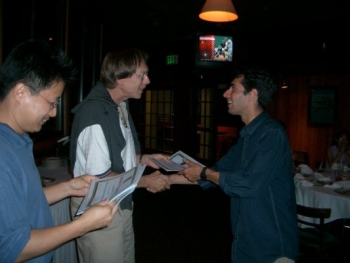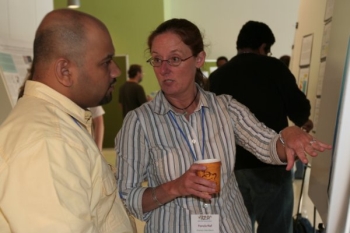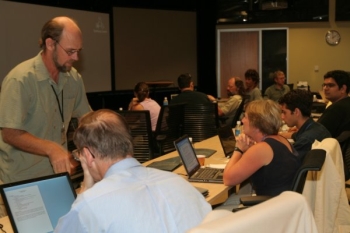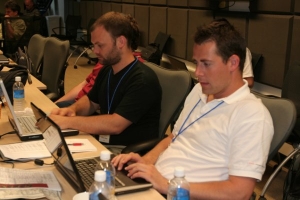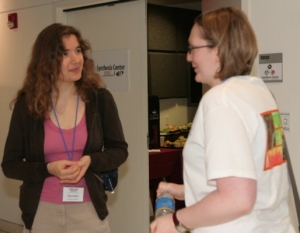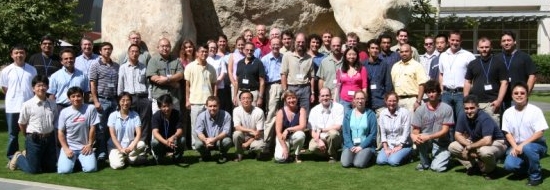NBCR Summer Institute Provides Hands-On Training With Scalable Computing Tools
By Maureen C. Curran
|
San Diego, CA, August 27, 2007 -- Nearly 70 researchers from around the world participated in the 2007 National Biomedical Computation Resource (NBCR) Summer Institute on Cyberinfrastructure and Multiscale Modeling Approaches. The week-long training program provided hands-on experience with cutting edge tools for biomedical research, as well as an overview of the state-of-the-art and understanding of the role of cyberinfrastructure in biomedical research.
The second annual Summer Institute began on Monday, July 30 with a day of plenary sessions held in the Calit2/San Diego Supercomputer Center Synthesis Center in Atkinson Hall. The morning sessions were a mini-symposium with keynote presentations from leaders in computational and informatics approaches to biomedical research.
NBCR director Peter Arzberger, co-organizer of the Summer Institute, opened the mini-symposium, highlighting NBCR's research efforts. "Our area of research is the development of cyberinfrastructure technologies for biomedical researchers," said Arzberger. "Before the students began their week of training, we wanted to provide them with the broader context in which they work, both NBCR's work and beyond." Arzberger is an active participant in Calit2 and is also the chair of the PRAGMA Steering Committee (PRAGMA is the Pacific Rim Application and Grid Middleware Assembly).
|
The keynote presenters included Brian Athey (Michigan Center for Biological Information, University of Michigan); Nathan Baker (Washington University); Alan Blatecky (Renaissance Computing Institute [RENCI]); Scott Delp (Center for Biomedical Computation, Stanford University); and Robert MacLeod (Scientific Computing & Imaging Institute, University of Utah).
"It's been fun to see what type of science is going on," said University of Utah's MacLeod, "especially what sort of integrative role that computing is playing in these projects." MacLeod presented "Applications of Biomedical Computing in the Heart."
The afternoon sessions on day one provided track highlights of the tools and training to come Tuesday through Friday. The presentations gave participants a chance to see the depth and breadth of research and development efforts from NBCR and their collaborators, who developed many of the tools on the curriculum.
"The expertise of those involved in Monday's presentations was extensive," noted Tracey Freitas, a microbiologist from the University of Hawaii, Manoa. He continued: "All of them made clear the necessity to continually develop the tools and computational resources needed to tackle the complexities of biology, as well as to support and educate a computationally interdisciplinary research community."
Hands-on training followed Monday's mini-symposium. There were six different course tracks -- two dozen training sessions, broken into three sessions each morning and afternoon over the four days. Students could choose two tracks.
|
RENCI's Blatecky works to address the needs of scientists and researchers who are not familiar with computational biology. He pointed out that "the only way they can really understand it, is to get access to the technology itself. The Summer Institute style of training is right on target." His keynote presented RENCI's TeraGrid BioPortal Gateway.
The training sessions provided two new tracks this year: "Programming Scalable Scientific Applications" and "Integrative Studies: Translational Biomedical Research."
Technology is moving quickly towards much more efficient and cost effective systems with multiple processors on the same motherboard. Scalable applications are necessary to take advantage of the computing power of these increasingly popular multi-core computers.
"Within a few years there will be multi-core systems with 128 CPUs readily available," asserted Wilfred Li, the executive director of NBCR and co-organizer of the Summer Institute. "It's something we would not have imagined five years ago. Beyond knowing how to take advantage of the computing environment, it will impact how people use the grid and the scale of the problems that researchers can actually tackle."
"This technology is enabling the emphasis on translational biomedical research because all this power, all this technological advancement, is ready to be put to use to really change the way people live, change the way people receive health care," noted Li.
The other four tracks were: Cluster and Grid Computing; Computational Cardiac Electro physiology and Mechanics; Molecular Electrostatics and Diffusion; and Molecular Visualization and Virtual Screening.
|
The training sessions attracted more than 50 students (biomedical researchers, postdocs and graduate students) representing 26 different institutions from 10 U.S. states and across the globe (China, Korea, Mexico, Norway and the United Kingdom); the other two dozen or so participants were session chairs, guest speakers and lecturers.
Martin Sandve Alnæs and Kristian Valen-Sendstad, researchers at Simula Research Laboratory, came all the way from Norway because Simula has had an ongoing collaboration with Andrew McCulloch and his group in the bioengineering department at UCSD on cardiac computations for several years. "So it was natural for me to come and learn from one of the world's experts," said Alnæs, who is a Ph.D. student. Simula is a national lab associated with the Norwegian universities. Valen-Sendstad, who will be a Ph.D. student next year, was also impressed: "The best things were Monday's overview and McCulloch's lectures."
"The two days doing AutoDock work have been the most interesting, that alone was worth the trip," said an enthusiastic Pamela Hall, a postdoc from the University of New Mexico. "It's been very useful, very beneficial," she continued, "and I like that the training materials will continue to be available online at the NBCR community portal after the meeting."
Hall was one of eight recipients of scholarships awarded by the Summer Institute to defray the costs of attending the meeting.
Also new this year, a poster session was held during the symposium. Recipients of the NBCR Summer Institute Scholarship presented posters along with local researchers on topics ranging from virtual screening for inhibitors, protein-DNA interactions, enzyme-substrate reaction mechanisms, cardiac systems modeling to cluster and grid computing platforms in support of the multiscale modeling research.
|
NBCR and the Summer Institute are supported by the National Center for Research Resources (NCRR), National Institutes of Health (NIH). Olga Brazhnik is the program officer in the division of Biomedical Technologies. She started the position just a few months ago and was very happy to be in attendance. "I am happy to be here, learning about all the scientific adventures that our PIs are involved in," she explained.
Brazhnik added: "The NBCR Summer Institute is a great showcase of synergistic interactions of technical and biomedical expertise, and productive multidisciplinary collaborations." NBCR and other NCRR Biomedical Technology Research Resources create unique cutting-edge technologies and apply them to a broad range of basic, translational, and clinical research.
The workshop also offered participants excellent opportunities for networking. Simula's Valen-Sendstad said, "It's a great thing to meet people working on the same thing." He and Alnaes also arranged meetings with researchers at UCSD for after the workshop.
"It's really nice to talk to other scientists and see what they're working on," noted Lily Cheng, "it gives you ideas about your own project." Cheng, a bioengineering and pharmacological chemistry major, just graduated from UCSD. For now, she plans to continue an avian flu research project with NBCR's Li, which she began as a PRIME student in 2006, working abroad in Beijing, China. PRIME is a summer program which offers cultural and research experiences to UCSD undergraduates; recipients work as full-time researchers at a PRAGMA partner institution in one of four Pacific Rim countries. PRAGMA is a partner of NBCR.
"It's a great opportunity for the students to see professors and high level scientists in discussions about real scientific problems," noted NIH's Brazhnik.
Jysoo Lee, a Calit2 visiting scholar and former director of KISTI, the Korean national supercomputing center, attended several sessions and was impressed: "From my experience, you can have all the new technologies available, but they are wasted without the crucial step of teaching and guiding scientists on how to use them. This is exactly what NBCR and the Summer Institute are doing."
|
Related Links
NBCR Summer Institute 2007
2007 Mini-Symposium
NBCR Summer Institute 2007 Wiki
NBCR Summer Institute Forums
National Biomedical Computation Resource (NBCR)
Pacific Rim Applications and Grid Middleware Assembly (PRAGMA)
National Center for Research Resources, National Institutes of Health (NCRR, NIH)


